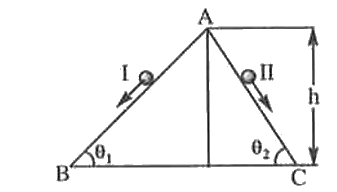Two inclined frictionless tracks, one gradual and the other steep meet at A from where two stones are allowed to slide down from rest, one on each track as shown in Figure. Which of the following statement is correct.
 Solution in Telugu
Solution in Telugu
Both the stones reach the bottom at the same time but not with the same speed
Both the stones reach the bottom with the same speed and stone I reaches the bottom earlier than stone II.
both the stones reach the bottom with the same speed and stone II reaches the bottom earlier than stone I
Both the stones reach the bottom at different times and with different speeds
The correct Answer is:C
Step by step video, text & image solution for Two inclined frictionless tracks, one gradual and the other steep meet at A from where two stones are allowed to slide down from rest, one on each track as shown in Figure. Which of the following statement is correct. by Physics experts to help you in doubts & scoring excellent marks in Class 11 exams.
Updated on:21/07/2023Topper's Solved these Questions
- WORK, POWER & ENERGY Book:AAKASH SERIESChapter:WORK, POWER & ENERGY Exercise:EXERCISE - II (SCALARS (OR) DOT PRODUCT)
Explore 9 Videos
- WORK, POWER & ENERGY Book:AAKASH SERIESChapter:WORK, POWER & ENERGY Exercise:EXERCISE - II (WORK)
Explore 20 Videos
- WORK, POWER & ENERGY Book:AAKASH SERIESChapter:WORK, POWER & ENERGY Exercise:PRACTICE EXERCISE (PERFECTLY INELASTIC COLLISIONS)
Explore 5 Videos
- WORK POWER ENERGYBook:AAKASH SERIESChapter:WORK POWER ENERGYExercise:EXERCISE - 3
Explore 61 Videos
Similar Questions
If →P=2ˆi+3ˆj−4ˆkand→Q=5ˆi+2ˆj+4ˆk. Find the angle between the two vectors.
View SolutionThe length of a smooth inclined plane of incilination 30∘ is 5 m. The work done is moving a 10kg mass from the bottom of the inclined plane to top is
View SolutionA shot moving with a velocity 140ms−1 collides a wooden block and comes to rest in it. If mass of the block is 13 times the mass of the shot, velocity of the block is
View SolutionIf →A+→B=→Rand2→A+→B is perpendicular to →B then
View SolutionTwo inclined frictionless tracks, one gradual and the other steep meet at O, from where two stones are allowed to slide down from rest, one on each track. Will the stones reach the bottom at the same time ? Will they reach there with the same speed ? Explain.
View SolutionTwo inclined frictionless tracks, one gradual and the other steep meet at a from where two stones are allowed to slide down from rest, one on each track as shown in Figure. Which of the following statement is correct ?
 .
.
View SolutionTwo inclined frictionless tracks , one gradual and the other sleep meet at A from where two stones are allowed to slide down from rest. One on each track as shown in figure. Which of the following statement is correct?

View SolutionTwo inclined frictionless tracks, one gradual and the other steep meet at A from where to stones are allowed to slide down from rest, one on each track (fig.) Will hte stones reach the bottom at the same time? Will they reach there with the same speed? Explain, given θ1=30∘, θ92)=60∘ and h=10m. What are the speeds and time taken by the two stones?

View SolutionA body is allowed to slide down a frictionless inclined track under gravity from a height of 10 cm . The track ends in a circular loop of diameter D. The body is just able to complete the circular track , then the diameter of the track will be
View SolutionTwo inclined frictionless tracks, one gradual and the other steep meet at A, from where two stones are allowed to slide down from rest, one on each track. Will the stones reach the bottom at the same time? Will they reach there with the same speed? Given theta_(1)=30^(@),theta_(2)=60^(@),h=10m . What are the speeds and time taken by the two stones?
View SolutionTwo inclined frictionless tracks, one gradual and other steep meet at 'A' from where two stones are allowed to slide down from rest, one on each track as shown in figure. The speed of two stones on reaching at bottom are v1andv2 respectively. v1&v2 are related as

View SolutionTwo inclined frictionless tracks, one gradual and the other steep meet at A from where two stones are allowed to slide down from rest, one on each track (Fig. 6.16). Will the stones reach the bottom at the same time? Will they reach there with the same speed? Explain. Given theta_(1)= 30^(@), theta_(2)= 60^(@)" and "h= 10m , what are the speeds and times taken by the two stones?
View SolutionTwo inclined frictionless tracks, one gradual and the other steep meet at A from where two stones are allowed to slide down from rest, one on each track (Fig. 6.16). Will the stones reach the bottom at the same time? Will they reach there with the same speed? Explain. Given theta_(1)= 30^(@), theta_(2)= 60^(@)" and "h= 10m , what are the speeds and times taken by the two stones?
View SolutionTwo inclined frictionless tracks, one gradual and the other steep meet at A from where to stones are allowed to slide down from rest, one on each track (fig.) Will hte stones reach the bottom at the same time? Will they reach there with the same speed? Explain, given theta_(1)=30^(@) , theta_92)=60^(@) and h=10m. What are the speeds and time taken by the two stones?
View Solutionदो घर्षणरहित झुके हुए पथ, जिनमें से एक तो क्रमिक (Gradual) तथा दूसरा एकदम ढालू (Steep) जो 4 पर मिलते हैं, जहाँ से दो पत्थरों को विरामावस्था से चित्रानुसार प्रत्येक पथ से एक को लुढ़काया जाता है। निम्न में से कौन-सा कथन सही है?

View Solution

